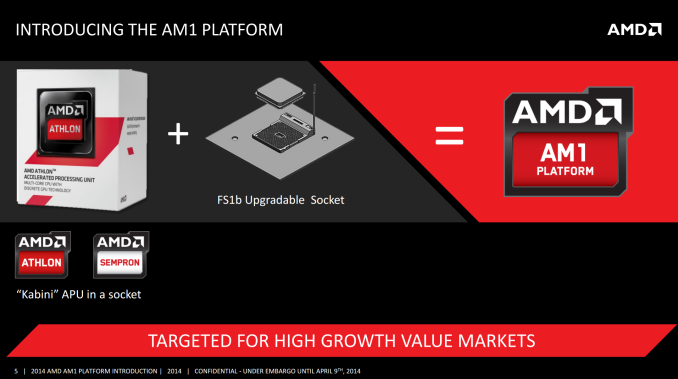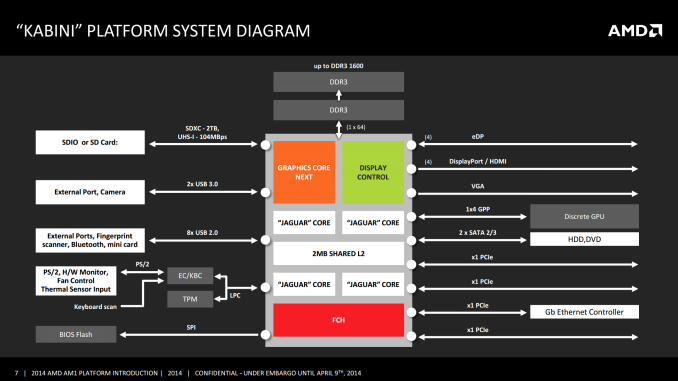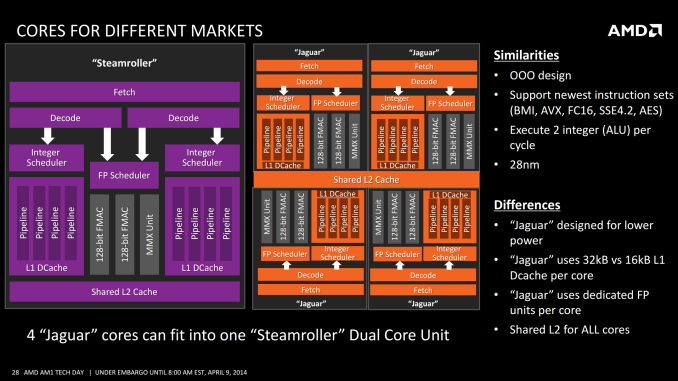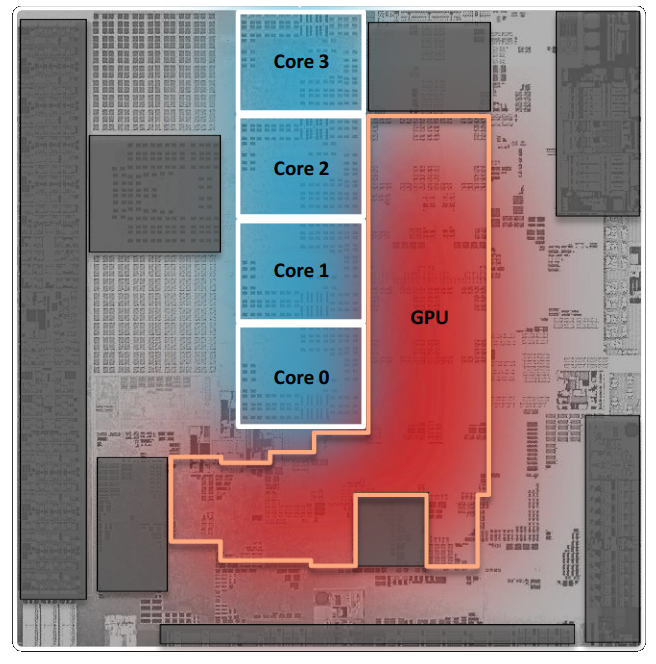AMD AM1 Kabini Part 2: Athlon 5350/5150 and Sempron 3850/2650 Tested
by Ian Cutress on May 29, 2014 2:00 PM EST
While there is a lot of focus on the mainstream desktop market, we hastily reviewed the new entrant to the low-end socketed desktop from AMD, the AM1 Kabini platform back in April. Since then we have acquired all four members of the family, the two quad core Athlon APUs and the two Sempron APUs, for testing. AMD’s movement into the upgradable tablet/desktop crossover arena is an interesting one for sure.
What Is The Point of AM1?
AMD’s reason for releasing a socketed low-power platform was derived from requests in low cost areas of the market. System integrators and companies in South America, Africa and Central Asia wanted a base system which would run an operating system which could be upgraded in the future to higher specification components, rather than sticking with a low-power but non-upgradable mobile CPU. The end result was AM1, the name given to a system using an FS1b socket with a desktop Kabini APU and an aim to build an upgradable CPU/motherboard combination for around $60.
Typically when dealing with the low cost/low power end of the spectrum, these systems are designed such that the APU is soldered on to the motherboard. When a user wants one model in particular, it comes as part of a package, much in the same way as a mobile device. In fact we even played a small game of ‘spot the desktop Kabini’ back at Computex 2013 and saw models such as the aptly named KBN-I from ECS, using the soldered A6-5200 APU:
These systems often find their way into applications that have long upgrade cycles, such as embedded and digital signage. The novelty of an upgradeable, socketed package makes most sense in the desktop arena. With low cost segments focusing more on the entry-level segmentation, AMD believe that having this upgradeability might drive pressure in the entry market towards these upgradeable PC-like devices.
AMD is marketing the series as a cheap, low powered way to go to quad core. When building a CPU architecture there is often a point in frequency scaling which is most efficient, and any deviation from that causes a less-than-linear gain in performance for power. Under this paradigm, and the importance of single core speed, the general feeling at AnandTech is that single core performance is preferred to more cores. If we can get the same multi-core performance using half the number of cores within the same power bracket, then this solution would be preferred. The final piece of that puzzle however comes in terms of design and price, both of which are points that AMD is also aiming to be competitive.
Desktop Kabini
There are a total of four AM1 APUs on the market:
| AMD AM1 Kabini APUs | ||||
| Athlon 5350 | Athlon 5150 | Sempron 3850 | Sempron 2650 | |
| CPU Cores | 4 | 4 | 4 | 2 |
| CPU Frequency | 2.05 GHz | 1.60 GHz | 1.30 GHz | 1.45 GHz |
| GPU Cores | 128 | 128 | 128 | 128 |
| GPU Frequency | 600 MHz | 600 MHz | 450 MHz | 400 MHz |
| Memory Frequency | 1600 MHz | 1600 MHz | 1600 MHz | 1333 MHz |
| L2 Cache | 2 MB | 2 MB | 2 MB | 1 MB |
| TDP | 25 W | 25 W | 25 W | 25 W |
| Official Launch Price | $59 | $49 | $39 | $31 |
Each of these APUs features up to four 28nm Jaguar cores and a 128 SP implementation of AMD's GCN GPU. We've gone over both the Jaguar and GCN architectures in previous articles, so we won't spend a lot of time recapping them here. Jaguar is the latest in AMD's line of "cat" cores, designed to go up against Intel's Atom. GCN on the other hand is a well-known GPU design from AMD as well, cut down here to fit in a much smaller die area (and thermal envelope).
The Jaguar cores in Kabini are listed as 3.1mm2, and AMD is quoting that four of these cores will fit into a single Steamroller module. Unfortunately the dimensions of a Steamroller module are not known - a 32nm SOI Bulldozer module clocked in at 30.9 mm2 for example, but no equivalent number is available for 28nm Steamroller. However some quick math shows four Jaguar cores populates 12.4 mm2. This leaves the rest of the core for the L2 cache, IGP and a large amount of IO.
In fact there are a few images that can help us predict total die size. In AMD’s slide deck, we have the following:
Given that one core is 3.1 mm2, extrapolating out gives the size of the die at 31.4x the size of a single core, or 97.3 mm2. The GPU area is approximately 5.2x the size of a core, giving ~16.1 mm2 for 128 GCN cores, compared to 12.4 mm2 for CPU cores. The Video Codec Engine and Unified Video Decoder are not part of these totals, located on other parts of the APU. The memory controller clocks in at ~9.4 mm2 and the display/IO portion runs at ~7.3 mm2.


















87 Comments
View All Comments
haardrr - Saturday, May 31, 2014 - link
but the i7-4675t is a 35 watt processor... does that mean that the i7-4675t competes with the 5350?Namisecond - Monday, June 9, 2014 - link
They are a lot closer in power usage than you might think, both idle and loaded.BMNify - Saturday, May 31, 2014 - link
why would you use a dual core anything to day ! , and these chips do not have AVX simd so are underpowered before you even start in 2014/15BMNify - Saturday, May 31, 2014 - link
also unless you are a large org looking to finally do mass signage in bulk then again these chips/soc are not worth it to day, if you want a few web enabled apps per Soc device then look to the http://cdn.liliputing.com/wp-content/uploads/2014/... for instance , now that will be worth the cash for something you want to actually buy on a whimhttp://liliputing.com/2014/05/crowdfunding-2-incre...
Crowdfunding: 3 incredibly tiny PC modules starting at just $15
silverblue - Saturday, May 31, 2014 - link
If you're including Kabini in that statement, the Jaguar architecture does indeed support AVX. In fact, it supports pretty much everything Piledriver does.BMNify - Saturday, May 31, 2014 - link
i wasn't, but again why settle for only old AVX , when you can have AVX2 AND a free hardware encoder and decoder that works for when you just want a quick conversion (or to make a new correctly time coded V/A fixed rate) http://forum.doom9.org/showthread.php?t=162442 Intel QuickSync Decoder - HW accelerated FFDShow decoder with video processing before you do the real x264 high visual quality encodeAlexey291 - Monday, June 2, 2014 - link
Why wouldn't you?The fewer the number of cores required to deliver equivalent performance the better.
Besides dual core cpu's are perfect for certain very real world applications - such as for example me typing out this message on a chromebook sporting a dual core haswell celeron.
eanazag - Tuesday, June 3, 2014 - link
Agree. I was looking for a cheap Haswell Pentium. Maybe you can compare in the bench.DanNeely - Thursday, May 29, 2014 - link
The graphs in this article leave a lot to be desired. The huge number of high power/performance chips only add clutter; at most 2 or 3 representative examples from each major vendor would suffice to show these processors are very low end performing. Alternately, use the color coding not to call out AMD vs Intel; but to highlight the 4 AMD chips being reviewed along the with the J1800/1900 celerons they're nominally competing with.Ian Cutress - Thursday, May 29, 2014 - link
I'll duplicate the graphs (after I eat dinner!) and limit the results data within a narrow band, and offer the option to switch between both.